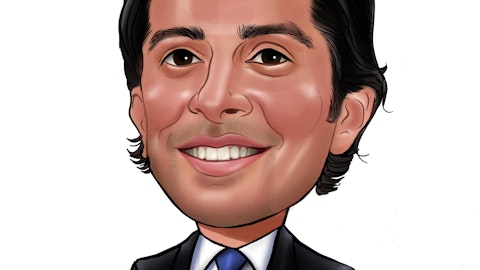It’s the overriding feature, I think. But we are also going to explore areas for increased growth as we do that, though, we’re going to do it in an efficient way. So if we decide to move into an adjacent market, you should not expect us to go hire 30 or 40 salespeople to go after it. As we identify opportunities, we’ll test, we’ll iterate, and we’ll try to do it in a super-efficient fashion.
Gray Powell: Understood, okay, that’s good to hear. And then I just had a question on sort of the cost savings that you achieved last year. So you have some good charts in the slide decks over the course of the year. I just want to make sure I understand it correctly. So the cost savings totaled close to 59 million at the end of 2023. I guess my question is like, what was the starting point on that cumulative number? Like, we know that 15.5 came out in Q4, we know that 24 million came out in Q3. Just wondering how much came out during the first half of the year, we tried to like sort of, just line up how things should have expanded?
Jorge Martell: Yes. So I can take that one, Gray. So if you look at sort of Q2 cumulative, and you have to take a step back and think about, we had the phase one and phase two, right, phase one was completed, the range for that was 10 to 12. We ended up I think 11.8. So close to the high-end, and that was completed early in 2022. Then Phase 2 kicked off and so I would say Q1 and Q2 from Phase 2, plus a lot of the new actions that we announced in Q2, that total about 19.1 million, right and so that was completed that is the number you will get, was 19.1 million in Q2. So like here, they and then in Q3, you add another 24 million that we discussed last quarter plus a 15.5 million this quarter. That’s your 58.5.
Gray Powell: Understood. So the trendline was 19, 24, 15.5, q2, q3, q4.
VictorLimongelli: You got it.
Gray Powell: Okay. Then, last one on my side. All right, so, I mean, I understand that the cost savings like [face-in] [ph], right, like these are sort of end of quarter numbers that we’re talking about. Was there anything like one-time in nature that created a headwind because I mean, we’re talking about like, huge cost saving numbers. But EBITDA for the year went from like 6 million to 12 million. So I’m just trying to like reconcile, like, what appears to be very large cost saving numbers versus the lower growth on EBITDA in 2023.
VictorLimongelli: Yes. I think I think part of the equation that you need to factor is that we started in Q1, and we’re sort of Q4. But we started in Q1 and the first half of Q2, really investing heavily in sales and marketing. And the thing that’s what the piece you also have to factor in. Just to give you an example, a number of sellers. We hired, I believe in the first four months of 2023, probably about close to 38, 39 sellers, right? And so when you start taking that investment that we made earlier in the year, then the offset with this cost savings, you have to take all into account to get to that a number.
Operator: [Operator Instructions] Our next question will come from the line of Alex Hantman with Sidoti.
Alex Hantman: Hi, this is Alex Hantman on for Anja Soderstrom. So my first question, I would love to hear a little bit more context around the guidance. So I think you mentioned that you’re on target for the low to middle of guidance for revenue and EBITDA, can you talk about some of the scenarios that bring you from the low to mid, and maybe even to higher end?
Jorge Martell: Yes, Alex. How are you doing? Thanks for the question. So I think part of that range is to account for the lumpiness that you see in the hardware business, as you know, is lumpy because of the timing of shipments. So part of the guide there is to consider that lumpiness. The other component is primarily on the term on the security software. That is, you’ll see this sometimes these pops up revenue, right. And that’s because again, [indiscernible] recognized upfront from a term license perspective. And so some of these deal may or may not close in a particular quarter particular year, you’ll have those pops, where you have a lot more seasonality or expectation of trends is more on the completely faster which is DA. And so that doesn’t play that much of a factor, although obviously there is some new logo, new revenue potential there. So those are the three factors, Alex, that I can comment to you regarding the range.
Alex Hantman: Thank you. Appreciate that. And I think you very briefly mentioned, sales force, but I was wondering if you could elaborate on average what level of productivity would you say the sales force has achieved? And how much room for improvement do you think there is?
Jorge Martell: Yes. We don’t normally comment on those metrics, Alex. One of the things that big outlook to get you can probably chime in here as well. But one of the things that we’re — this has been tasked with, obviously, you certainly find efficiencies, and that includes sales and marketing. And that includes working with [Sammy and Sameer] [ph] as the GMs to improve the efficiency of our sales dollar spent as well as the productivity for our sellers. So Vic, I’ll turn it over to you for additional comments there.


